Today's picture is a twin of Friday's. But in this one, the alstroemeria is in focus while the cat, if you look carefully, is just a blur.

Cats, charts, and politics

Today's picture is a twin of Friday's. But in this one, the alstroemeria is in focus while the cat, if you look carefully, is just a blur.

Did you know that 23,000 shipping containers have been lost at sea since 2008? That's about 1,500 per year. In 2020 there was a huge spike to 4,000 containers, which prompted the World Shipping Council to start a safety campaign. In 2022 a mere 661 containers were lost:
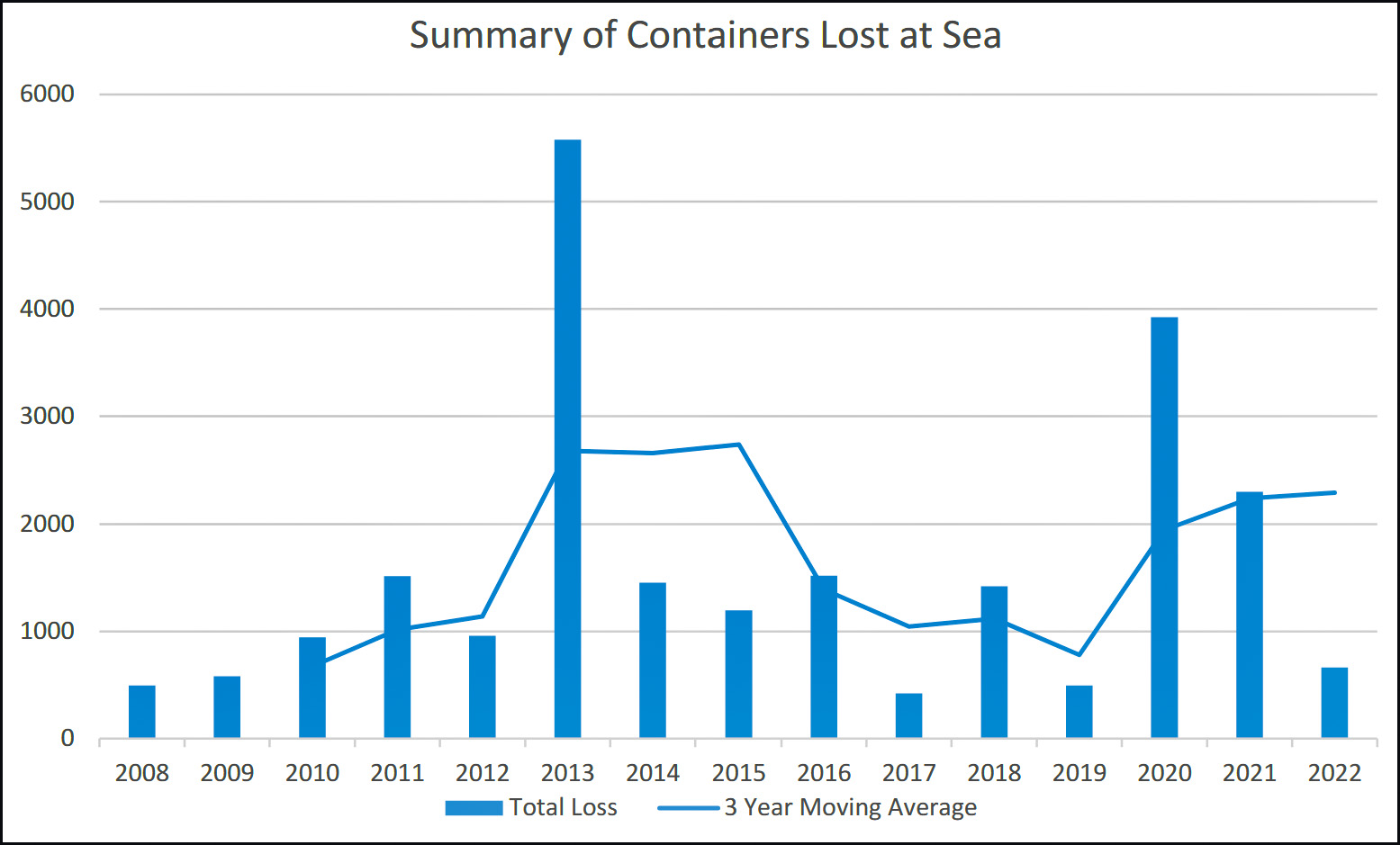 The WSC would like you to know that the 2022 total amounts to only 0.00048% of the 250 million containers shipped that year—or possibly even less if you do the arithmetic correctly.¹ Also, the leading cause of lost containers is parametric rolling in following seas. And the WSC is committed to improving container safety.
The WSC would like you to know that the 2022 total amounts to only 0.00048% of the 250 million containers shipped that year—or possibly even less if you do the arithmetic correctly.¹ Also, the leading cause of lost containers is parametric rolling in following seas. And the WSC is committed to improving container safety.
I wonder what was in all those containers now bobbing around in the ocean?
¹My trusty Windows calculator returns 0.00026%.
Everyone's campaign strategy against Donald Trump appears to have converged on the same tactic: trolling. It's all about deliberately hurling insults at him in the hope that he'll melt down completely and eventually lose the plot.
Neither Nikki Haley nor Joe Biden are even trying to hide this. They're all but daring Trump to maintain his composure, confident that he can't do it even when he knows he's being baited.
Do you think it will work? I do.
Here is data from three different survey-based studies. First is loneliness among the elderly over the past few generations:
 Next is loneliness among high school students over the past three decades up to 2012:
Next is loneliness among high school students over the past three decades up to 2012:
 Finally, here is Gallup's survey of overall loneliness since the pandemic:
Finally, here is Gallup's survey of overall loneliness since the pandemic:
 Based on these numbers, the best guess is that loneliness among the elderly has been flat for a long time and loneliness among everyone else has been going down in recent years.
Based on these numbers, the best guess is that loneliness among the elderly has been flat for a long time and loneliness among everyone else has been going down in recent years.
The Washington Post writes today about 49ers fullback Kyle Juszczyk:
His skill set is hard to see on TV, and the data collected by the computer chips in his shoulder pads doesn’t really stand out.
Wait. Computer chips in his shoulder pads? Oh yes:
Two chips tucked within both shoulder pads on every NFL player will send out a wireless signal to receivers at every stadium. The data is used to better train players, helping with coaching decisions, and improves tactics for teams.
The data is monitored in real time at the company's command center in San Jose, California. During games, broadcasters get information almost instantly, and for the first time, the stats are delivered to teams the very next day.
That's from 2016. I really need to start paying closer attention to things.
Aquifers around the world are being drained at an alarming speed. Here's what that looks like in two of the biggest aquifers in the US:
 Red dots are bad (more than one meter per year of water loss). This is from a recent paper that examines 1,693 aquifers around the world:
Red dots are bad (more than one meter per year of water loss). This is from a recent paper that examines 1,693 aquifers around the world:
Rapid groundwater-level declines are widespread in the twenty-first century, especially in dry regions with extensive croplands. Critically, we also show that groundwater-level declines have accelerated over the past four decades in 30% of the world’s regional aquifers.
When we have unlimited cheap fusion we'll be able to desalinate and pump water anywhere we want. But that's probably a ways off. In the meantime, maybe we should stop sticking our heads in the sand and face reality?
Terri Gerstein writes today about a couple of cases of employee misclassification in Denver:
At issue is whether dishwashers and others like them, placed in their jobs by online temporary staffing agencies, are employees of the agencies or independent contractors running their own businesses.
....The cases demonstrate the spread of the exploitative gig business model far beyond Uber drivers and DoorDash food deliverers, to encompass a growing number of jobs that have long been performed by employees with legal protections. And the cases illustrate the urgent need for government intervention to safeguard core workplace rights.
I'm all for proper labor protection, but I'm also all-in on correct labor statistics. Here's the number of temp agency workers:
 It's lower today than before the pandemic. Here's a BLS estimate of all contingent workers:
It's lower today than before the pandemic. Here's a BLS estimate of all contingent workers:
 The BLS only rouses itself to produce these figures every once in a while, so this chart is fairly out of date. A new one will come out later this year. And recent research suggests the BLS may be undercounting. Still, the trend is pretty obvious: it's going down.
The BLS only rouses itself to produce these figures every once in a while, so this chart is fairly out of date. A new one will come out later this year. And recent research suggests the BLS may be undercounting. Still, the trend is pretty obvious: it's going down.
Even op-eds should require a minimal amount of fact checking. You can be against exploitive work arrangements without misstating the facts.
Two nights ago Microsoft gifted me with a Windows update on my Surface tablet, and now I can't read anything in the Wall Street Journal. Every story looks like this:
 Oddly, this is what you get if you don't have a subscription and the Journal paywalls you. But I do, I'm up to date, and I'm signed in. How could an OS update cause this?
Oddly, this is what you get if you don't have a subscription and the Journal paywalls you. But I do, I'm up to date, and I'm signed in. How could an OS update cause this?
Everything is still fine on my desktop. But what happens when Microsoft does its magic there too?
UPDATE: I restored the system to its previous state and now everything is fine. It really was the Windows update that caused this. Very strange.
Immigration, man. I don't know.
Right now the Senate is working on a compromise immigration bill, but as usual the immigration hawks are doing their best to sink it because they aren't getting 100% of what they want. Some of this is campaign cynicism, but not all of it. It's what they've done over and over. They really seem to have a death wish of some kind, preferring to keep the border porous rather than doing at least something to tighten it up.
For the rest of us, the problem is that immigration is a really complicated subject, which makes it genuinely hard to know what kind of effect a large bill might have. The new thing among Republicans is griping about Joe Biden's increased use of parole, which is understandable in a way since it lets hundreds of thousands of immigrants enter the country legally with just some paperwork. On the other hand, it also cuts down on border chaos since those hundreds of thousands aren't trying to brave the razor wire in Texas and sneak in.
But the really big difference between now and the past is asylum. Instead of merely trying to evade detection and capture, lots of migrants are now giving themselves up and applying for asylum. That creates a legal thicket, since if you ask for asylum the law says you have to be given a hearing. This is called affirmative asylum. Likewise, if you're in a deportation hearing and declare that you're seeking asylum, a judge has to hear your claim. This is called defensive asylum. Both have skyrocketed in recent years:
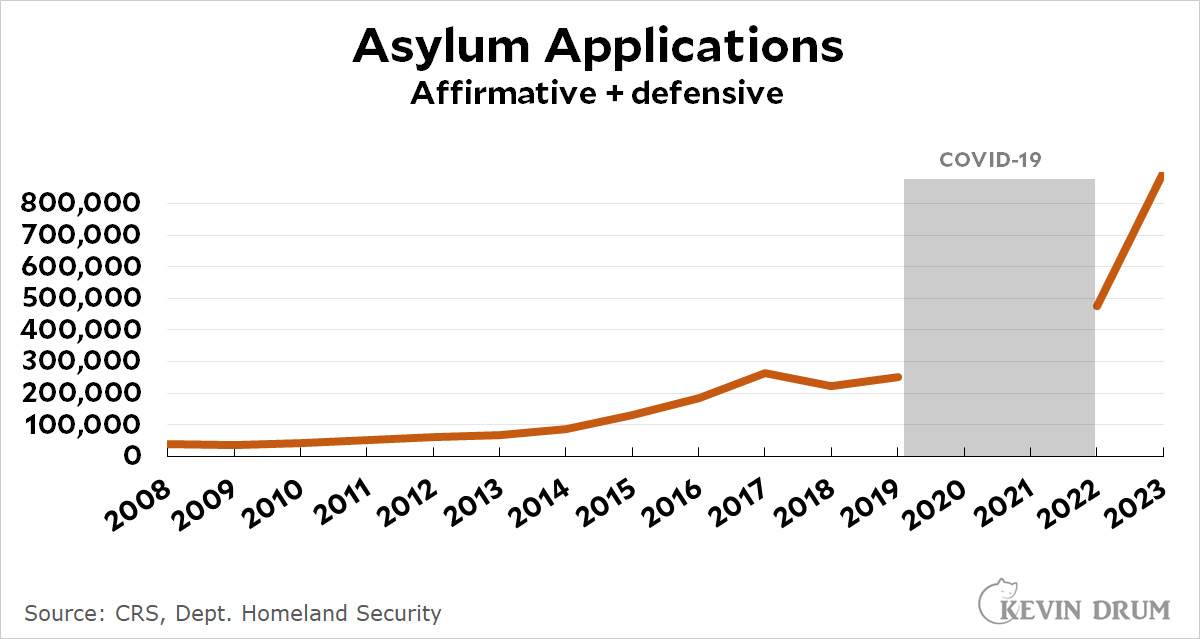 But there's more here than meets the eye. Asylum requests have surged, but ordinary old illegal immigration has too:
But there's more here than meets the eye. Asylum requests have surged, but ordinary old illegal immigration has too:
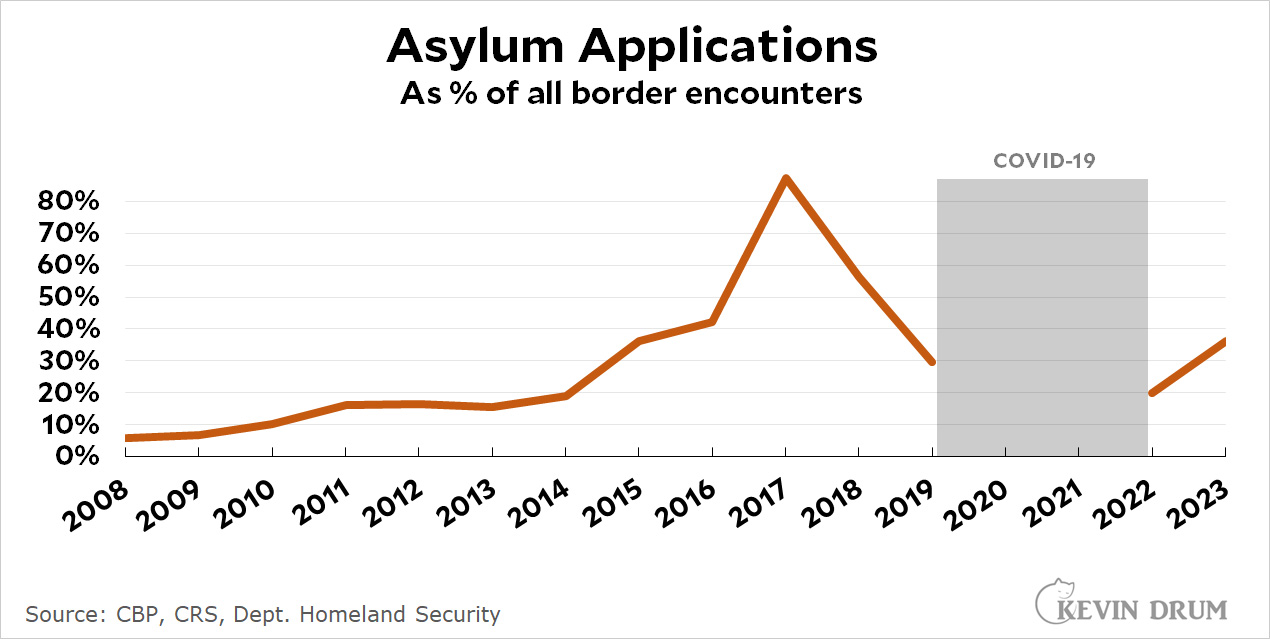 Asylum as a percentage of all illegal immigration peaked in 2017 under Donald Trump; bounced around during COVID; and then started to rise again under Biden. But in 2023 it was still only about a third of all immigration cases. Plain old economic migrants looking for jobs was much higher.
Asylum as a percentage of all illegal immigration peaked in 2017 under Donald Trump; bounced around during COVID; and then started to rise again under Biden. But in 2023 it was still only about a third of all immigration cases. Plain old economic migrants looking for jobs was much higher.
This combination calls for a combination of actions. Asylum seekers generally aren't successful, but nonetheless nearly half of asylum requests are approved. The Senate bill tightens up the requirements for asylum, which is something worth doing. The bigger problem, however, is that we have a huge backlog of asylum seekers roaming around the country waiting years for a hearing. The answer is more judges and more case officers, which the Senate legislation also provides.
At the same time, ordinary economic migrants could be most effectively dealt with via E-Verify. If you make it hard to hire undocumented workers, they'll stop coming. The problem is that even immigration hawks tend to downplay this because it might actually work, and that would piss off the business community that wants lots of cheap foreign labor.
The Senate bill would reportedly make asylum harder; increase the number of judges; reduce parole; and create a mechanism for quick expulsions. But those are quiet, technocratic changes. It doesn't include big, flashy stuff like building a wall; sending illegal immigrants back to Mexico without a hearing; or building mass detention camps. It would also increase legal immigration. As usual, hardliners are dead set against half a loaf, which likely means they'll once again get nothing. For 20 years they've gotten nothing. It's a mystery that they haven't gotten tired of this yet.
NOTE: Affirmative asylum applications for FY08-14 are here. Affirmative asylum applications for FY15-22 are here. Affirmative asylum applications for FY23 are here. Defensive asylum applications for FY08-23 are here.
I'm glad you asked. Here's the latest data from the CDC:
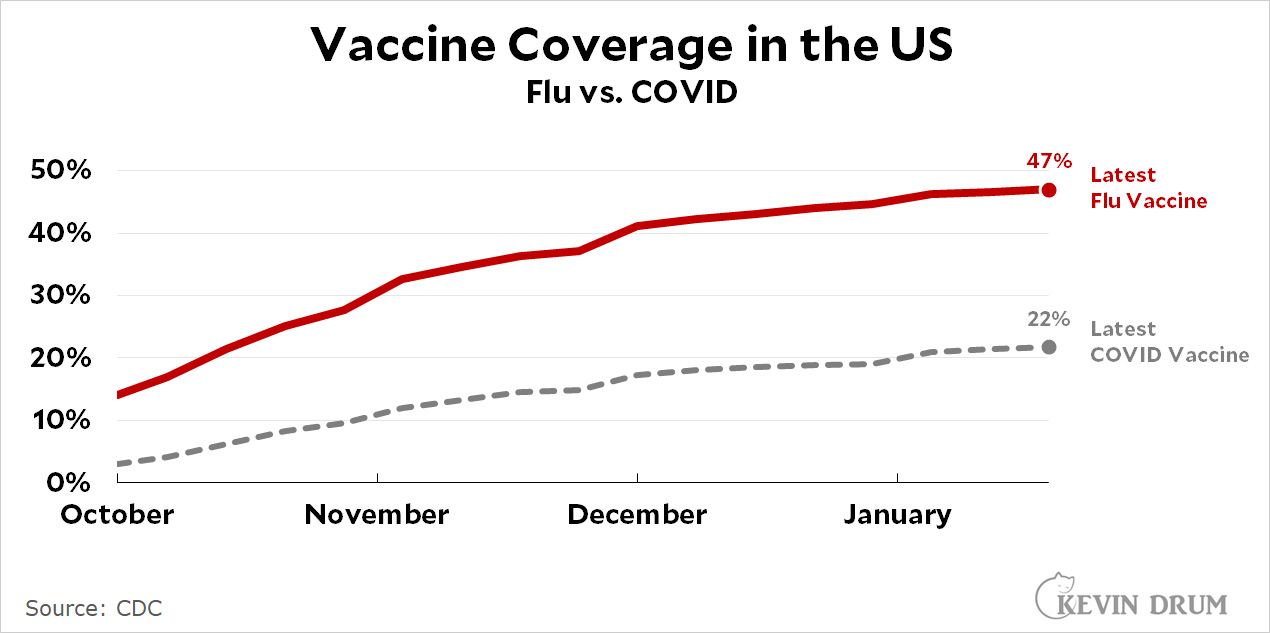 Half of us have gotten a flu jab this season but only a fifth of adults have gotten the latest COVID vaccine. How come? Dr.
Half of us have gotten a flu jab this season but only a fifth of adults have gotten the latest COVID vaccine. How come? Dr.
When I ask my patients if they have any concerns or questions about the Covid vaccine, hardly any do.... There’s just a vague hedge, or an abashed, “I don’t know, I just don’t.” As I try to suss out what’s on my patients’ minds, I can feel their own slight sense of surprise that there is no specific issue causing their discomfort about getting the updated Covid vaccine. It’s as though they have a communal case of the heebie-jeebies.
....These patients are not anti-vaxxers; they take their shingles vaccines and tetanus shots with hardly a shrug. Nearly all received the initial Covid vaccine series, and fully remember the urgency of getting those hard-to-find vaccination slots in the early days. Nor do they seem to be science deniers; they embrace standard medical treatments for most of their other health conditions.
Lately, COVID has seemed like more of a nuisance than a killer. This probably drives some of the hesitance. But flu is also more of a nuisance than a killer for most of us. And there's been enough talk about long COVID that you'd think people would be eager to do anything they can to avoid it.
Perhaps the low coverage rate is because of the widespread anti-vax sentiment among conservatives? A map of vaccine coverage suggests it might be:
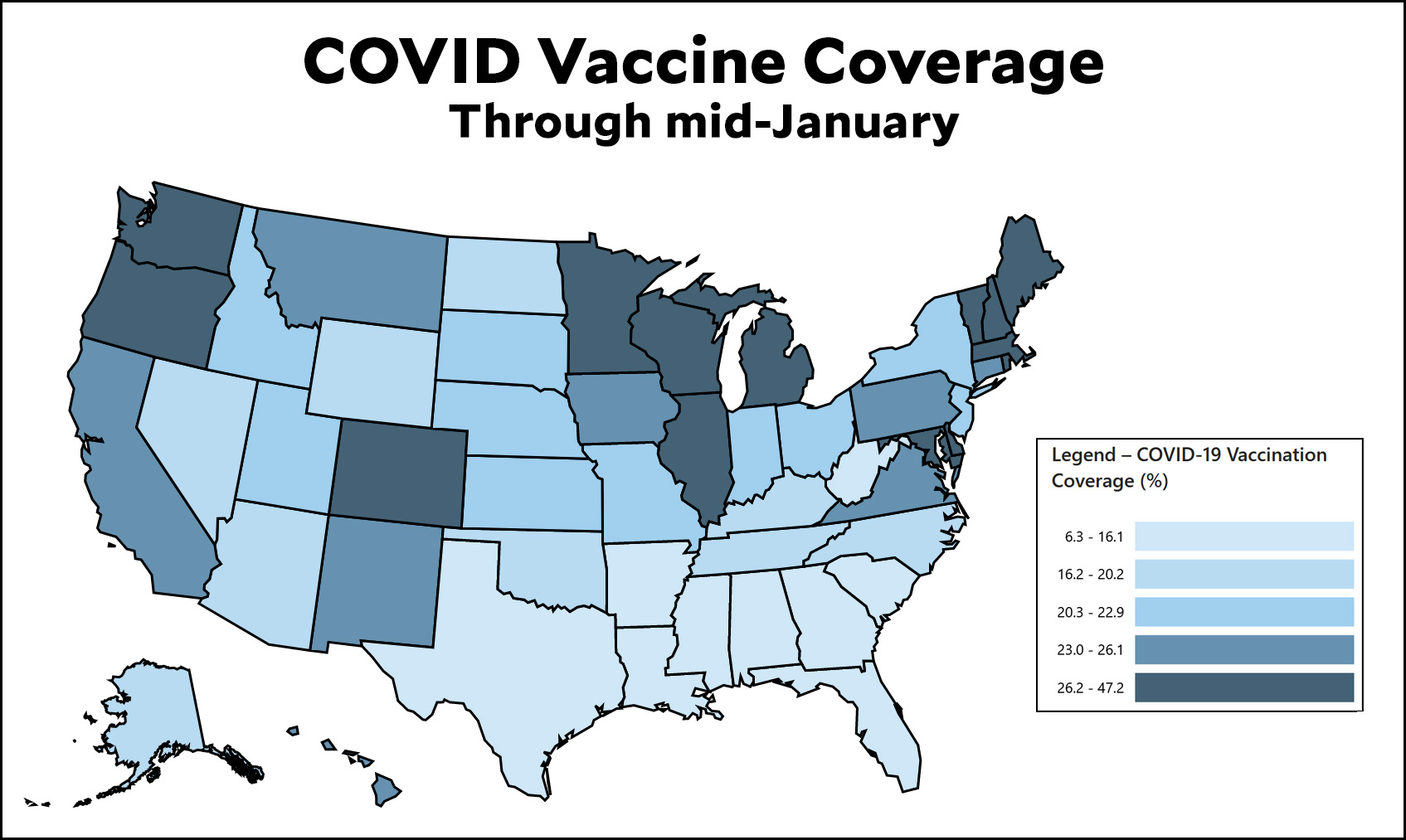 Red states have generally low coverage and blue states have generally higher coverage. On the other hand, we can also look at international vaccine rates:
Red states have generally low coverage and blue states have generally higher coverage. On the other hand, we can also look at international vaccine rates:
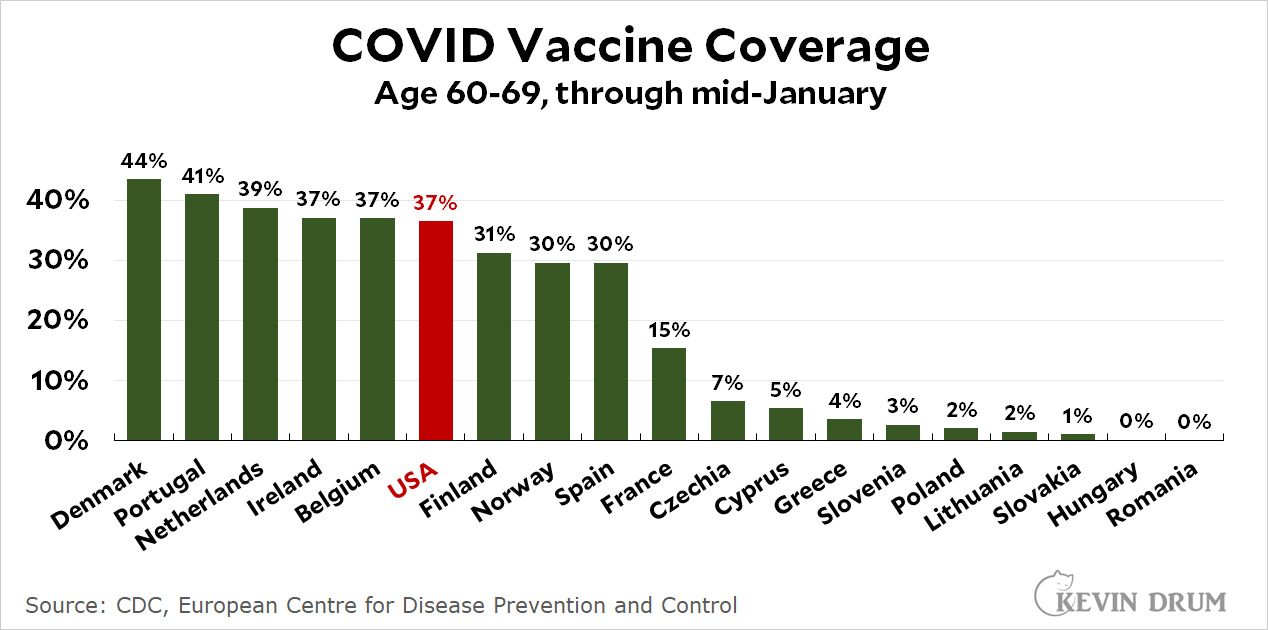 The EU, annoyingly, doesn't report overall COVID vaccination coverage for the current season, but it does report coverage for those aged 60-69 years. The US, annoyingly, doesn't precisely report the 60-69 age range. However, interpolating from other age ranges provides a pretty good estimate, and it turns out the US is entirely normal. If fact, it's one of the more highly vaccinated countries, with a rate considerably higher than the EU average.
The EU, annoyingly, doesn't report overall COVID vaccination coverage for the current season, but it does report coverage for those aged 60-69 years. The US, annoyingly, doesn't precisely report the 60-69 age range. However, interpolating from other age ranges provides a pretty good estimate, and it turns out the US is entirely normal. If fact, it's one of the more highly vaccinated countries, with a rate considerably higher than the EU average.
So the reason for lack of interest in the latest COVID vaccine seems twofold. First, there's a generalized COVID fatigue everywhere. Second, there's resistance to the vaccine among conservatives in the US. That's my best guess, anyway.